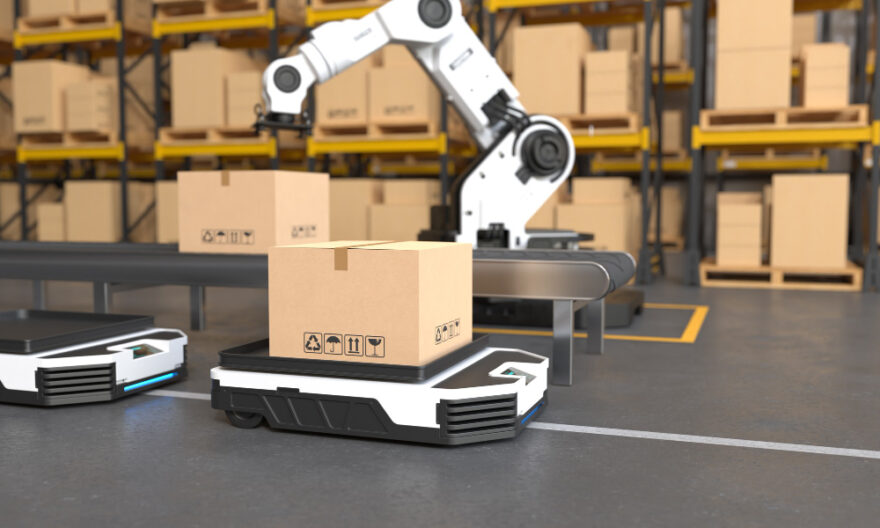
Have you ever watched workers loading boxes onto pallets for hours—nonstop, no breaks, no end?
How long do you think a human spine can tolerate that before filing for early retirement?
Welcome to the wonderful world of robotic palletizer, where machines do the heavy lifting—literally—and automatic robots are quietly saving Malaysian manufacturers time, money, and a lot of backaches.
Smart and fast production lines attract growing market interest. In Malaysia, robotic palletizers are no longer futuristic luxuries—they’re becoming operational essentials. Automatic robots are helping local manufacturers work faster, safer, and more efficiently. Whether it’s electronics in Penang or palm oil in Johor, robotic palletizers are streamlining operations across industries.
What Exactly Is a Robotic Palletizer?
Let’s not overcomplicate things
A robotic palletizer is a type of automatic robot that stacks boxes, cartons, or other products onto pallets. Think of it as the Tetris master of manufacturing. Except, it doesn’t get tired, doesn’t complain, and won’t file a union grievance.
These machines are programmed to sort, lift, rotate, and place items with precision and speed. What once required several people now takes just one robotic arm and a few lines of code.
Why Malaysian Manufacturers Are Making the Switch
Because labor isn’t cheap—and mistakes are even costlier
Malaysia’s manufacturing sector isn’t small potatoes. From semiconductors to snack foods, efficiency is the name of the game. A robotic palletizer can work three shifts without blinking—perfect for 24/7 production floors.
Here’s why manufacturers are replacing sweaty brows with steel arms:
- Reduced labor costs: Automatic robots don’t require monthly wages, sick leave, or staff lunches.
- Fewer injuries: No one pulls a muscle or gets crushed under a falling crate anymore.
- Consistent output: Machines don’t lose focus. Humans, well… we’ve all seen post-lunch productivity dips.
Speed, Accuracy, and Other Perks You Can’t Ignore
No more “Oops, wrong stack again” moments
Robotic palletizers don’t guess where the box should go. They know. They’re built for exact stacking patterns and can handle a wide range of packaging types, sizes, and materials.
Benefits you can bank on:
- Higher throughput: More boxes per minute equals more products out the door.
- Smaller footprint: These machines are compact and often take up less space than a team of workers.
- Integration ease: Robotic palletizers can connect to existing conveyor and packaging lines without fuss.
Have you ever seen a human stack 25 boxes a minute without error, while doing it upside down? Me neither. But an automatic robot? It’s another Tuesday.
A Friend to the Environment Too
Robots don’t waste tape or energy—unless programmed to
Sustainability isn’t just about solar panels and biodegradable packaging. Efficiency matters. Robotic palletizers help reduce waste by minimizing packaging damage and avoiding excess material use. Fewer damaged goods = fewer returns = a lighter carbon footprint.
Also, by optimizing pallet loads, these robots help reduce the number of trips needed for transportation. That’s fewer trucks on the road, less fuel used, and more savings for everyone involved.
But What About the Workers?
Isn’t this just replacing jobs?
Here’s the twist: robotic palletizers aren’t kicking humans out of the factory—they’re moving them up the chain. When automatic robots take over repetitive, risky tasks, human workers can focus on safer, more skilled roles like programming, quality checks, and maintenance.
And guess what? Someone still needs to manage the robot. Preferably someone who won’t press the emergency stop button just for fun.
Training workers to work alongside machines opens the door to higher wages, better safety, and smarter factories. It’s not about removing people—it’s about upgrading the entire operation.
Can Malaysian Businesses Afford Not to Use Them?
Let’s do the math
Yes, robotic palletizers involve an upfront investment. But the return? Massive.
Over five years, a robotic palletizer can pay for itself multiple times over through:
- Reduced downtime
- Fewer accidents
- Lower product damage
- 24/7 reliability
And let’s not forget: automatic robots don’t go on strike, take smoke breaks, or check their phones.
Manufacturers already using robotic palletizers report faster production cycles, fewer operational errors, and happier teams. Why? Because no one wants to be stuck stacking boxes all day while a robot watches from the sidelines.
Where Does Malaysia Stand in the Global Game?
Somewhere between catch-up and leapfrog
Malaysia’s adoption of automation is growing fast, particularly in key sectors like E&E (electrical and electronics), automotive, and food processing. As international clients expect faster turnaround times and flawless delivery, the pressure is on.
The good news? Robotic palletizers are no longer reserved for billion-dollar factories. Mid-sized manufacturers are jumping in, too—often with government support for automation upgrades.
Now the question is: Will your factory be the one still hiring stackers, or the one setting the new standard?
The Verdict: Work Smarter, Not Harder
Automatic robots like robotic palletizers aren’t just convenient—they’re transforming how Malaysian factories think about labor, output, and long-term strategy. The benefits are clear:
- Safer workplaces
- Smarter use of human talent
- Faster product movement
- Fewer errors and delays
As automation gains speed, standing still is not an option. The smarter move is to explore how robotic palletizers can fit into your line before your competitor beats you to it.
Now ask yourself—are you still stacking boxes the old way? Or is it time for an upgrade?



